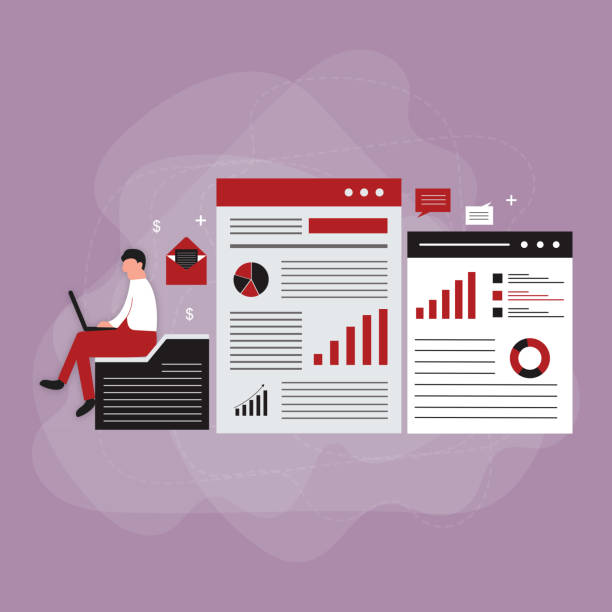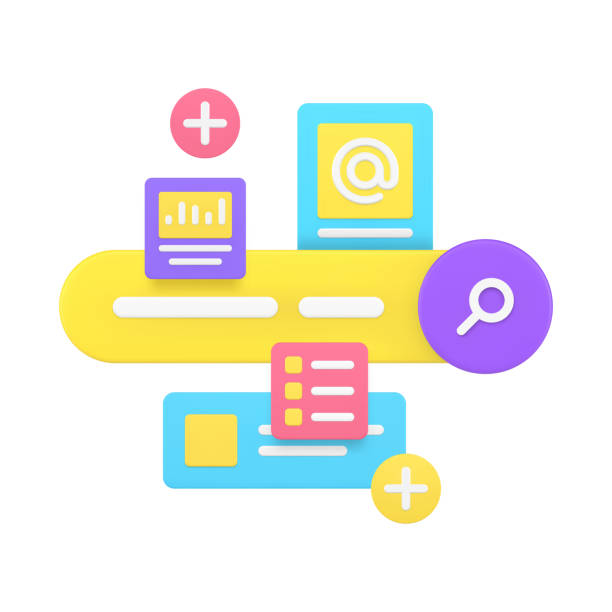Introduction to Modern UI Website Design

In today’s digital world, where competition for user attention has become more intense than ever, #Modern_UI_Website_Design is no longer a luxury choice, but a necessity.
User Interface (UI) and User Experience (UX) are fundamental elements that determine the quality of user interaction with a website.
Modern user interface means creating visually attractive, efficient, and intuitive environments that not only meet user needs but also provide an enjoyable and seamless experience.
The main goal of this approach is to reduce user friction, increase conversion rates, and ultimately, strengthen customer loyalty.
A website with an old or unfriendly user interface quickly exhausts users and drives them towards competitors who have paid more attention to this crucial aspect.
This is particularly important for businesses, as a website acts as their online storefront.
From a user’s perspective, ease of use, loading speed, and responsive design are among the most important factors that contribute to a desirable user experience.
Modern UI website design goes beyond mere aesthetics; this process involves a deep understanding of user behavior, analyzing their needs, and implementing solutions that allow them to easily and without confusion achieve their goals on the website.
This approach ensures that every visitor, whether on a mobile phone, tablet, or personal computer, has a consistent and optimized experience.
Are you tired of your e-commerce site having visitors but no sales? Rasaweb solves your main problem with professional e-commerce website design!
✅ Significant sales increase with targeted design
✅ Flawless user experience for your customers
⚡ Get a free consultation!
Key Principles in Creating an Attractive and User-Friendly Interface

To achieve a truly effective and modern user interface design, adherence to fundamental design principles is essential.
The first principle is “Clarity”; the user interface should be designed so that users can easily understand what they need to do in each section of the site and where they are being guided.
“Consistency” is also of particular importance; design elements, from fonts and colors to button placement and navigation, should be consistent throughout the website to prevent user confusion.
“Feedback” is also vital; the system should provide an appropriate and immediate response to every user action, whether it’s a small animation to confirm a click or an error message.
“Efficiency” means facilitating user tasks with the least effort and time.
This includes optimizing workflow and reducing unnecessary steps.
Finally, “Aesthetics” and visual appeal play a significant role in attracting initial attention and building a sense of trust in users.
A pleasant visual design, even if it has high efficiency, can improve the user experience.
Integrating these principles leads to the creation of websites that are not only beautiful but also incredibly functional and intuitive.
Focusing on these principles helps designers go beyond mere appearances, delving into the depth of user interactions with the website and creating an unforgettable experience.
New Tools and Technologies in Modern Website Design

To implement a modern UI website design, designers and developers require a set of advanced tools and technologies.
In the field of user interface design, tools such as Figma, Adobe XD, and Sketch have gained special prominence.
These software solutions facilitate collaborative design, interactive prototyping, and usability testing with ease.
Figma has become very popular in large teams and complex projects due to its cloud-based nature and real-time collaboration capabilities.
Adobe XD, with its deep integration into the Adobe ecosystem, is ideal for designers who use other software from the company.
In front-end development, JavaScript frameworks such as React, Vue, and Angular have revolutionized the way dynamic and responsive web applications are built.
These frameworks, by offering reusable components and optimized state management, make development faster and more efficient.
Additionally, CSS preprocessors like Sass and Less enable writing more modular and maintainable CSS code.
Finally, project management tools like Trello or Jira help teams manage the design and development process in an organized and transparent manner.
Using these tools not only increases work speed but also significantly improves the final product’s quality and enables the implementation of the most complex design ideas.
Comparison of User Interface Design Tools
| Tool | Key Features | Suitable for |
|---|---|---|
| Figma | Real-time collaboration, web-based, strong prototyping, component system | Large teams, collaborative projects, UX/UI designers, developers |
| Adobe XD | Integration with Adobe ecosystem, wireframe to prototype design, animation tools | Designers using other Adobe products, individual and small team projects |
| Sketch | macOS only, extensive plugins, active user community, Symbol system | Professional UI/UX designers, small to medium teams (Mac users only) |
The Role of Responsive Design in Modern User Experience

In the current era, where using various devices to access the internet is common, the importance of Responsive Design in modern UI website design becomes more apparent than ever.
Responsive design means that your website displays correctly and functions properly regardless of the screen size of the device the user is on (whether mobile phone, tablet, or desktop).
This approach means providing a seamless and optimized user experience for all users, without the need to develop separate versions for each device.
Search engines like Google also prioritize responsive websites, as these sites offer a better user experience, which in turn helps improve SEO and increase site ranking.
The lack of responsive design can lead to a high bounce rate and reduced user time on site, as users quickly abandon websites that do not display correctly on their devices.
Therefore, investing in responsive design is not just a technical requirement but a strategic investment for business success in the online space.
This type of design directly impacts user satisfaction and ultimately business goals, as modern users expect websites to display smoothly and functionally regardless of the tool they use.
Are you tired of your e-commerce site having visitors but no sales? Rasaweb solves your main problem with professional e-commerce website design!
✅ Significant sales increase with targeted design
✅ Flawless user experience for your customers
⚡ Get a free consultation!
Why is Usability Testing and User Feedback Crucial?

After the initial implementation of a design, the process of usability testing and gathering user feedback is of vital importance.
This stage helps you identify design weaknesses and ensure that the website is truly effective for end-users.
Improving the user experience of modern websites is impossible without a direct understanding of how users interact with them.
There are various methods for usability testing, including A/B testing, where you show two different versions of a page or element to different user groups to see which one performs better.
Moderated usability tests, where a designer or researcher interacts directly with the user and observes their behavior, provide valuable qualitative data.
Additionally, surveys, interviews, and heatmap analysis can offer deep insights into user behavior on the website.
It is crucial that feedback is continuously collected and fed back into the design improvement cycle.
This iterative and continuous process enables the website to constantly keep pace with changing user needs and expectations, providing a dynamic and optimized experience.
Ignoring user feedback can lead to designs that appear excellent from a designer’s perspective but are confusing or ineffective for users in practice.
New Trends and the Future of Web User Interface Design

The world of modern UI website design is constantly evolving, and every year we witness the emergence of new trends that elevate the user experience to higher levels.
One prominent trend is the popularity of “Dark Mode”, which not only helps reduce eye strain but also gives websites a sleek and modern appearance.
“Micro-interactions” have also gained an increasing role; these small and subtle animations, such as a button changing color after a click or showing loading progress, provide visual feedback to the user and make the overall experience more enjoyable.
The use of “3D and Depth design” with shadows and gradients to create a greater sense of realism in the user interface is also expanding.
Furthermore, Artificial Intelligence (AI) and Machine Learning (ML) are increasingly being used in optimizing the user interface and personalizing the user experience.
These technologies can tailor content based on user history and preferences.
Other important trends include “Voice User Interface” (VUI) and “Neumorphism,” which is a minimalist and prominent style.
It is predicted that in the future, user interfaces will become even more personalized, leveraging data to provide a completely unique experience for each user, so that every interaction feels fresh and innovative.
Challenges of Implementing Advanced User Interface Design

Despite all the advantages that modern UI website design brings, its implementation is not without challenges.
One of the biggest obstacles is “budget constraints.”
Designing and developing an advanced user interface requires significant expertise and time, which can be costly, especially for small and nascent businesses.
Another challenge is “technical issues.”
Some complex visual designs and interactions may require high technical knowledge in front-end and back-end development, and sometimes their implementation with existing website infrastructures can be difficult or impossible.
“Integration with legacy systems” is also a common problem.
Many businesses have outdated internal systems, and harmonizing a new user interface with them can be complex and time-consuming.
Moreover, “resistance to change” from internal stakeholders or even users can be an obstacle to the adoption of a new design.
“Expectation management” is also important; designers must have realistic expectations regarding technical capabilities and project timelines.
Finally, “maintaining simplicity” while adding advanced and modern features is a difficult balance.
Overly complex design can lead to a poor user experience, even if it is visually stunning.
Overcoming these challenges requires careful planning, cross-functional collaboration, and a step-by-step approach to ensure the new design can be implemented as effectively as possible.
Common Challenges and Solutions in Modern UI Design
| Challenge | Suggested Solution |
|---|---|
| Budget Shortfall | Prioritizing features, using customizable templates, hiring freelancers |
| Technical Issues and Implementation Complexity | Close collaboration between designer and developer from the outset, choosing appropriate technologies, training the development team |
| Integration with Legacy Systems | Using APIs, designing middleware layers, gradual migration |
| Resistance to Change | Educating and raising awareness among stakeholders, demonstrating the benefits of new design with data, involving teams |
Successful Examples of Stunning UI Website Design

Looking at successful examples of modern UI website design can be inspiring and demonstrate how excellent design can impact the success of a product or company.
Airbnb, the accommodation booking platform, is one of the most prominent examples.
Their user interface design strongly focuses on “simplicity, clarity, and high-quality imagery,” which turns searching and booking accommodation into an enjoyable experience.
Extensive use of white space, intuitive navigation, and step-by-step processes help users reach their goals without confusion.
Spotify, the music streaming service, is also known for its minimalist and personalized user interface.
This platform provides an unparalleled listening experience by focusing on ease of content access, personalizing playlists, and offering music recommendations based on user taste.
Google Material Design is also an example of a comprehensive design system developed by Google and used by many applications and websites due to its modern aesthetics, smooth animations, and practical principles.
These examples demonstrate how design is not just a visual factor but a strategic element for building customer loyalty and business growth.
Focusing on actual user needs and providing a logical and visually appealing workflow is key to the success of these brilliant examples.
Are you tired of your company’s website not meeting your expectations? With Rasaweb, design a professional website that truly represents your business.
✅ Increased acquisition of new customers and sales leads
✅ Enhanced brand credibility and trust among your audience
⚡ Get a free website design consultation!
Measuring Success and Return on Investment in Modern Web Design
![]()
To ensure that investing in modern UI websites has been fruitful, measuring success and Return on Investment (ROI) is crucial.
This requires defining specific Key Performance Indicators (KPIs) that can measure the impact of the new design on business objectives.
Some of the most important KPIs include: “Conversion Rate,” such as the rate of purchase, registration, or download, which indicates what percentage of visitors have become customers.
“Bounce Rate,” which shows the percentage of users who leave a site after visiting one page without any interaction.
A decrease in bounce rate usually indicates a better user experience.
“Time on Site” and “Pages per Session” are also metrics for measuring content engagement and site navigation.
Additionally, “User Satisfaction Score,” collected through surveys or direct feedback, provides valuable insights from the users’ perspective.
To calculate ROI, you can compare the costs of the new design with the increase in revenue or reduction in support costs resulting from an improved user experience.
Data analysis on an ongoing basis and conducting A/B tests help you continuously improve your design and ensure that every change has a positive impact on business objectives.
This data-driven approach transforms web design from a purely artistic activity into a strategic lever for growth.
Next Steps for Businesses Towards Modern UI Website Design

After a deep understanding of the importance and principles of modern UI website design, it’s time for practical steps for businesses.
The first step is to “evaluate your current website’s status.”
Identify the weaknesses and strengths of your current UI and understand actual user needs through data analysis and feedback.
Next, “defining clear goals” for the new design is essential.
What do you want to achieve with the new design? Increased conversion rates? Improved customer satisfaction? Or entering new markets? The next step is “investing in expertise.”
This means hiring skilled UI/UX designers or collaborating with specialized agencies that can bring fresh perspectives and the necessary technical knowledge to your project.
“Adopting an iterative and agile approach” in the design and development process allows you to quickly implement changes and integrate user feedback along the way.
This means not being afraid of trial and error and continuous improvement.
Also, the “importance of training and culturalization” within the organization should not be overlooked.
All team members, from marketing to developers, must understand the importance of user experience.
Finally, remember that user interface design is a continuous process, not a one-time project.
Your website should be updated with new trends, emerging technologies, and changing user needs.
By following these steps, businesses can ensure that their website is not only visually appealing but also effectively contributes to their business goals and delivers a superior experience for users.
Frequently Asked Questions
| Row | Question | Answer |
|---|---|---|
| 1 | What is meant by “modern UI website design”? | It refers to designing a website that uses the latest trends and best practices in User Experience (UX) and User Interface (UI) to make user interaction simple, engaging, and efficient. |
| 2 | Why is a modern user interface important for a website? | A modern user interface leads to increased user satisfaction, improved conversion rates, extended user time on site, and creates a professional and up-to-date brand image. |
| 3 | What are the key elements of a modern user interface? | Key elements include simplicity and minimalism, responsiveness, use of white space, attractive typography, subtle animations, an appropriate color palette, and intuitive navigation. |
| 4 | What role does responsiveness play in modern UI design? | Responsiveness ensures that the website displays correctly on any device (mobile, tablet, desktop) and provides a seamless user experience, which is essential for modern UI. |
| 5 | How important is typography in modern UI design? | Typography plays a crucial role in readability, visual hierarchy, and brand visual identity. Modern fonts and their combinations can contribute to the overall beauty and attractiveness of the site. |
| 6 | How are animations and micro-interactions used in modern design? | Animations and micro-interactions are used to provide visual feedback, guide the user, and add a sense of dynamism and appeal to the user interface, provided they are not excessive. |
| 7 | What is the role of User Experience (UX) in modern UI design? | UX is the foundation of modern UI. A modern design must first be functional, understandable, and enjoyable (UX), and then beautiful and appealing (UI). |
| 8 | What tools are used for modern UI design? | Tools such as Figma, Adobe XD, Sketch, and InVision are used for design, and frameworks like React, Vue.js, or Angular are used for implementation. |
| 9 | How can overly complex design be avoided in modern UI? | By focusing on minimalism, removing unnecessary elements, utilizing ample white space, and adhering to the “Less is More” principle. |
| 10 | What is the importance of user testing in modern UI design? | User testing ensures that the designed user interface is truly useful, understandable, and engaging for users, and that potential issues are addressed before launch. |
And other services of Rasaweb Advertising Agency in the field of advertising
Smart Social Media: An effective tool to increase sales by utilizing real data.
Smart Content Strategy: A novel service for increasing customer acquisition through custom programming.
Smart UI/UX: A combination of creativity and technology to increase click-through rates by precise audience targeting.
Smart Custom Software: A combination of creativity and technology for digital branding through user experience customization.
Smart Marketplace: A fast and efficient solution to increase website traffic with a focus on intelligent data analysis.
And over hundreds of other services in internet advertising, advertising consultation, and organizational solutions
Internet Advertising | Advertising Strategy | Sponsored Content
Sources
Principles of UI/UX Design
Modern User Interface Design Trends
The Importance of Professional Website Design
How to Improve Your Website’s User Experience?
? For your business to leap forward in the digital space, Rasaweb Afarin Digital Marketing Agency, with expertise in SEO, targeted content marketing, and user-friendly website design, is the guide to your success.
📍 Tehran, Mirdamad Street, next to Bank Markazi, Southern Kazerun Alley, Ramin Alley No. 6


